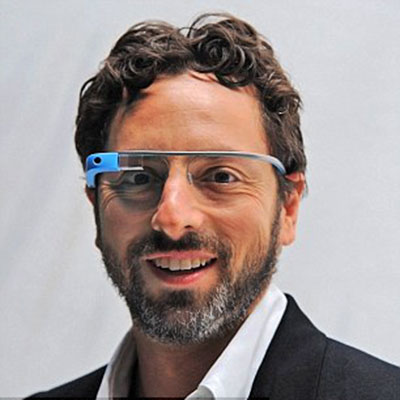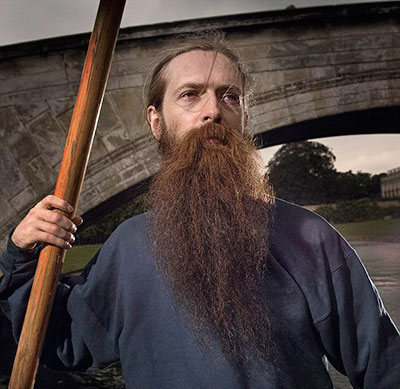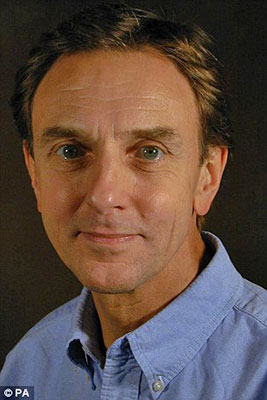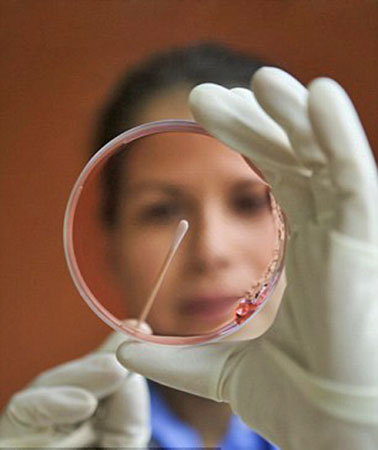|

by Tom Leonard
02 April 2015
from
DailyMail
Website
Spanish version
Quest to prolong human
life indefinitely
obsesses the rich and powerful.
The head of Google's investment arm
thinks it is possible to live
to 500.
America's tech moguls
are spending billions of
dollars to defeat ageing.
They're Spending Fortunes on the
Research they Hope will make it Possible
The ancients believed in a magical elixir, a potion that would grant
what man most desired - eternal life.
Chinese emperors chased the dream by consuming long-lasting precious
substances such as jade and gold, often with fatal effects.
Elizabeth Bathory, a 16th-century Transylvanian countess
dubbed Lady Dracula, made an even more drastic attempt to
conquer death, by bathing in the blood of young girls.
One infamous scientist, meanwhile, would inject himself with a
concoction that contained dog semen, testicles and blood. At least
he didn't have to drink it, unlike those Jamaicans who followed
their country's secret recipe for longevity - tortoise scrotum soup.
Today, the quest to prolong human life indefinitely still obsesses
the rich and powerful. Indeed, the head of internet giant Google's
multi-billion-dollar investment arm announced that he believes it is
possible to live to 500.
'We have tools in the life sciences to achieve
anything you have the audacity to envision,' said Bill Maris. 'I
just hope to live long enough not to die.'
In his industry, Bill Maris is far from alone
in harboring the conviction that galloping advances in science and
technology may soon overturn the one thing, apart from taxes, of
which we are certain - for now.

Google co-founder Sergey Brin
talks of one day 'curing death'
Led by the phenomenally wealthy Google, whose
co-founder Sergey Brin talks of one day 'curing death',
America's tech moguls are quietly ploughing billions of dollars into
researching how we can defeat the ageing process.
Some are driven by a genuine if questionable desire to help mankind,
some by personal loss, and others by the fear of dying.
Money, too, is a motivator. If anyone does find a way of allowing us
to live for decades or even centuries longer, they would stand to
become exceedingly rich. Nor is the prospect as outlandish as it may
seem.
It's easy to laugh at these rich techie types who think they can
'solve' ageing as if it were another computational puzzle.
With software mogul Larry Ellison calling it
'incomprehensible' that people accept death as inevitable, they can
seem to be in the grip of a communal mid-life crisis.

British gerontology theorist
Aubrey de Grey
believes the first person who
will live to 1,000 has already
been born
But the first person who will live to 1,000 has already been born,
according to British gerontology theorist Aubrey de Grey. He
believes such longevity will be achieved by genetically engineering
the cells of our body to avoid the ageing process.
Before you scoff, scientists have already managed to dramatically
increase the lifespans of worms, flies and even mice in this way.

Sir Colin Blakemore,
former chief executive of the
British Medical Research Council,
insists there is an upper limit to
how much the human body can age
We need to stop thinking that ageing is inevitable, says De Grey,
and view the body like a vintage car:
maintained properly, it can keep on going
indefinitely.
Peter Thiel, the co-founder of the internet
payment service PayPal, has given him $3.5 million (£2.3 million)
towards his work in this field.
Other scientists dismiss all this as lunatic nonsense which hijacks
research funds that could be far better used elsewhere.
For example, Sir Colin Blakemore, former chief executive of
the British Medical Research Council, insists there is an
upper limit to how much the human body can age - and thus how long
we can live.
He puts that boundary at 120 years, primarily on the grounds that
hardly anyone has ever survived longer.
Yet research centers with some of the world's finest scientists are
already working on ever more outlandish ways of extending our
lifespan, from genetic engineering, to using microscopic robots to
tackle failing cells, to replacing body organs with robotic or
cloned versions, to - perhaps most startling of all - plans to
'upload' the human consciousness into machines.
Of course, all of this frenetic activity raises a mountain of
ethical issues.
-
How much will it all cost, and will the quest
for immortality divert resources away from research into
everyday sickness and disease?
-
What are the implications for our already
overcrowded planet?
-
And if the robotic techniques do work, will
we still be human - or more machine?
-
More fundamentally, though a few pampered
billionaires can't imagine their wonderful lives ever
ending, do the rest of us want to go on for ever?
In films and books, we have a name for those who do
just that, complaining about the loneliness and monotony of eternal
life.
They're called vampires...

Unlocking the genetic secrets of the
naked mole rat,
which is found in Africa, has been
another priority
for those trying to solve the
ageing puzzle
Techniques they are using
Rewriting our DNA
Google's secretive life-extension research arm, the California
Life Company (CALICO), has recruited scientist Cynthia Kenyon, who
has genetically engineered roundworms to live up to ten times
longer than usual.
She achieved this by partially disabling a single gene - called
daf-2. Intriguingly, humans who live to 100 are more likely to
have mutations in this gene.
Kenyon believes it possible,
'that a fountain of youth, made of molecules
and not simply dreams, will some day be a reality'.
Google's research unit is also believed to be
developing a drug that can mimic another gene which appears to
limit the height to which people grow, but which is also linked
with exceptional longevity.

Unlocking the genetic secrets
of an ugly creature called the
naked mole rat,
which is found in Africa, has
been another priority
for those trying to solve the
ageing puzzle.
The unlovely, hairless creature is immune to
cancer, and lives ten times longer than ordinary subterranean
rats (more than 30 years).
Experts think its longevity is linked to the fact it has so
little oxygen to breathe in the underground tunnels where it
exists. This keeps its metabolism incredibly slow, which in turn
drastically reduces the rate at which its cells age and die.
Miniature robots
Google's director of engineering, Ray Kurzweil, predicts
that by the 2030s we will be putting millions of microscopic
robots - called nanobots - inside our bodies to turbo-charge our
immune systems and keep us healthy at a 'molecular level'.
These tiny medical devices, each the size of a human blood cell,
and swallowed in pill form, would travel through our bloodstream
delivering hormones and patching up the human body from within.
The aim is to counter harmful side-effects of treatments such as
chemotherapy, which are often caused by the drugs that are
pumped into the body not reaching the targeted cells accurately.
Nanobots, though, can be targeted with pinpoint accuracy at
specific cells, or even specific sections of DNA within our
cells. Experiments on animals have already had successes - with
rats cured of diabetes using nanobots.
Many scientists ridiculed Kurzweil's sci-fi sounding ideas when
he first set them out in a book a decade ago.
Now, the skeptics are less critical.

Peter Nygard, a
Canadian billionaire,
has his own stem cells growing
in a petri dish
Eternal life... in a petri dish
Another attack on ageing is the use of stem cells, the
microscopic building blocks of our bodies.
One man convinced they are the answer is Peter
Nygard, a Canadian billionaire, who is staking much of his
fortune on researching their uses.
Stem cells have the potential to develop into many different
kinds of human tissue, meaning they can be introduced into the
body as 'spare parts' to repair faulty cells or organs.
Scientists have extracted them from blood, teeth, bone marrow
and body fat.
Nygard, a fashion empire founder in his 70s, has his own stem
cells growing in a petri dish, and injects them into his body
four times a year.
Not only does he think he'll live longer, he's
sure he'll get younger.
'This is huge. This is a game-changer. This
could eliminate all disease. This is perhaps immortality,'
he boasts in a promotional video in which he compares his
pioneering research to the achievements of Leonardo da
Vinci.
Some scientists say his obsession with reversing
the ageing process gives stem-cell research a bad name, because
it detracts from the serious life-saving work being done in the
field.
But New York doctor Lionel Bissoon agrees with him,
saying:
'If you're a wealthy guy and haven't stored
your stem cells, I think you're a total idiot.'
The search for new blood
Some believe the answer to longer life may lie in swapping our
ageing blood for fresher, younger blood.
Pope Innocent VIII died in 1492 after it was said he drank the
blood of three young boys in an attempt to absorb their
vitality. Although the transfusion experiment failed with tragic
results, he may have been on to something.
Tests on mice have shown that blood plasma from young mice can
restore the mental capabilities of older mice. This was
originally achieved by a macabre process known as
parabiosis,
which sounds like something out of Dr Frankenstein's notebook.
The flanks of two animals - one old and infirm, the other young
and healthy - were stitched together so that their blood
supplies mingled.
Experiments showed that while the older mice got younger and
healthier, the younger ones aged prematurely.
Today, a human trial is under way at California's Stanford
university to test if a similar result occurs when Alzheimer's
sufferers receive blood transfusions - via intravenous drips -
from younger people. Thankfully, this doesn't involve them being
stitched together.
Tony Wyss-Coray, the project's leader, says that, if
successful, it is hoped to isolate what it is in the younger
blood that is responsible, and try to turn it into a drug to
treat disease.
But others clearly see alternative uses: after publishing his
own research on mice, Wyss-Coray says he was contacted by 'many
healthy, very rich people' asking if it could help them live
longer.
Advance of the clones
Another prospect, equally chilling to some, is the idea of
replacing failing body organs with cloned or robotic versions.
Kazuo Ishiguro's dystopian novel
Never Let Me Go
imagined a future in which a group of young people gradually
understand they are clones of the rich, and that their healthy
body parts will be given to their 'owners' when they need them
in a process that will eventually kill the youngsters.
Replacing failing organs doesn't need to be quite so brutal,
however.
Scientists have already managed to use 3D printing to create
living kidneys and livers, in a process that involves blending
samples of human organ cells with
hydrogel, a water and
nutrition-rich material.
Even if a person were dying, it's thought new organs could be
implanted via a procedure called 'cold saline resuscitation', in
which the patient's blood was replaced with chilled saline -
salted water - thus lowering the body's temperature and putting
the patient into suspended animation.
Doctors would then have the opportunity to deal with organ
failures that would otherwise have been fatal.
Half-man, half-machine
Eccentric Russian internet billionaire Dmitry Itskov is
investing millions in a project to transfer human brains - and
with them our 'consciousness' - into robotic 'avatars',
physically superior representatives of ourselves.
He says he plans to enjoy,
'10,000 years for numerous hobbies'.
Some go still further.
Ray Kurzweil, Google's 'futurist', is convinced
that,
'immortality is within our grasp'.
He predicts that by 2045, computers will have
surpassed us in intelligence, and humans will be able to,
'transcend biology by
merging with
technology' - uploading their consciousness into a computer.
He will be 97 by then, but is determined to be
alive to benefit from this new phase of human evolution, which
he calls
The Singularity.
So determined is he, in fact, that he is attempting to
're-program' his body's biochemistry by swallowing 150 dietary
supplements every day, from vitamin D to a 'co-enzyme' called
Q10, which plays a role in turning sugar into energy for the
cells.
|






